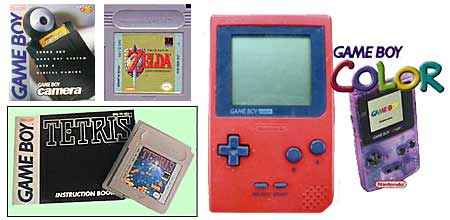Game Boy

Synopsis of Toy
In some small way, you have to believe that Nintendo’s Game Boy was inspired by those countless moms asking, “Why don’t you go play outside for a change?” Game Boy was like the legal loophole that got you out of that fix: Mom saw you out enjoying the fresh air and sunlight, while you got to stay wired in to the latest Mario adventure. Everybody’s happy.
Nintendo had already been dominating the home video game market for years by the time the Game Boy came out in 1989, but this was a totally different beast. Unlike the Nintendo Entertainment System (NES) or other traditional home games, Game Boy wasn’t bound to a TV. The little gray unit was completely portable—small, light, and battery-powered. Nintendo had already experimented with portable gaming during the company’s Game and Watch years, but the Game Boy was a fully self-contained unit with changeable cartridges. With an ever-expanding library of game titles, owning a Game Boy was like owning a portable arcade…well, kind of.
In order to conserve battery power and keep costs down, the Game Boy was strictly a black-and-white affair (or more accurately, black-and-greenish), displaying its graphics on a small LCD screen. As a trade-off, however, the Game Boy came complete with a revolutionary new idea in home gaming: linked play. By means of an included linking cable, two Game Boys could be joined together to play the same game, with each player getting his or her own view of the action. With this one-on-one angle, the lack of color didn’t seem to bother action-hungry gamers, who snatched up Game Boys in numbers far exceeding color competitors like Sega’s Game Gear and the Atari Lynx (the latter of which, to be fair, supported linked play that exceeded even the Game Boy’s).
As always, the biggest reason for Game Boy’s success was in the games. The Game Boy was blessed with extraordinarily good timing in this regard. A Russian-made puzzle game called Tetris had been a favorite of PC gamers since 1987, and its momentum had built through an arcade version in 1988. Nintendo announced Tetris as its pack-in title for the U.S. release of the Game Boy, and anticipation ran high. Those who hadn’t yet sampled the addictive pleasures of building rows of four-square blocks soon learned what they had been missing, and before long, both Game Boy and Tetris were video game superstars.
Tetris was clearly the first great star of Game Boy’s show, but it was only the beginning. Over the next decade, Game Boy became the best-selling game system of all time, and over 500 titles were produced for the portable dynamo. Mario made his customary appearance in Super Mario Land and other titles, as did Link and the Zelda crew in Zelda: Link’s Adventure. The linked play made for a series of highly competitive sports games like Tennis, Baseball and the later NBA Jam and NFL Quarterback Club series, while good old shoot-em-ups were ably represented by titles like Gradius. The Final Fantasy Legend series was a favorite RPG of many, and when Street Fighter II and Mortal Kombat made fighting games the genre of choice, Game Boy obliged with versions of those and other one-on-one slugfests.
But the biggest thing to happen to Game Boy in many a year arrived in 1998 in the form of several little “pocket monsters.” Pokémon egged on Game Boy-toting youngsters with the catchphrase, “Gotta Catch ‘Em All,” and as several new Pokémon cartridges were released (Red, Blue, Yellow, Silver, Gold and so on), Pokémon training became a sort of international sport of choice.
Game Boy remained virtually unchanged for most of its first nine years, but its list of accessories had a few standouts. A Super Game Boy add-on allowed Game Boy cartridges to be played in color on the Super NES, while a Game Boy Camera and Printer actually let kids take snapshots and print them in pixilated black and white. A Game Boy Pocket shrank the size of the machine in the late 90’s, but the real revolution arrived in time for the holiday season of 1998. Game Boy Color finally delivered full-color games to the classic system, even adding new color to old games.
With the long-awaited addition of color, the Game Boy entered its second decade as powerfully as it did the first. An entire library of new, exclusively Game Boy Color titles was (and still are) produced, and the hand-held system even moved into the 32-bit future with 2001's Game Boy Advance. The best-selling game system is still a must-have on long car trips, airline flights and anywhere a bored kid needs a little video pick-me-up.
Release History of Toy
1989 - Game Boy1998 - Game Boy Color
2001 - Game Boy Advance
Sub Categories of Toys
gameselectronic games
